Who's Afraid of the Big Bad Wolf? Steirischer herbst in Graz
Door Pieter Vermeulen , op Fri Oct 03 2025 09:30:00 GMT+0000At steirischer herbst in Graz, art is never apolitical. Pieter Vermeulen’s sharp chronicle of this year’s edition, tellingly subtitled Never Again Peace, places the festival’s unsettling works against a backdrop of war, censorship and resurgent authoritarianism. From Candice Breitz's political statement to grotesque right-wing rants staged in Michiel Vandeveldes Violenza, the pieces gathered here probe what remains of art’s freedom in a time marked by exftreme violence.
September 2025, the onset of autumn – or should I say fall. Once again, I find myself in Graz for steirischer herbst, the interdisciplinary arts festival with a progressive political legacy. I call it a festival, even though there is little to celebrate. Beyond this town, nicknamed Pensionopolis, the world is burning. Israel has just launched its ground offensive on Gaza City – an operation it claims will take months, aimed at delivering the ultimate and fatal blow to what remains of Palestinian life. Two years after the horrific Hamas attacks of October 7, 2023, tens of thousands – mostly civilians – have been killed, and millions driven from their homes. Independent experts commissioned by the U.N. Human Rights Council now confirm what many have long cried out: Israel is committing genocide. Meanwhile, on Europe’s eastern flank, Russia’s war on Ukraine grinds on. Its so-called ‘special military operation’, begun on 24 February 2022, has become a brutal war of attrition – cities bombarded, civilians crushed beneath the machinery of imperial aggression. The world watches: some in outrage, some in despair, many in silence. What we are witnessing is not mere ‘conflict’, not just another ‘crisis’. Such euphemisms obscure what is plainly before us: war, unmasked and merciless. Its face is a barren wasteland, a heap of broken images, fragments shored against the ruins of civilization. And while violence dominates the headlines, its origins and consequences too often remain in the shadows. This is why it matters which stories are told, and which are silenced. Against the flexing of muscles by global superpowers, individual stories may appear small, but they are not futile. Can art confront violence and resist authoritarianism, or is it merely swept up in their wake?
Memory politics
This year’s steirischer herbst, directed by Ekaterina Degot since 2018, carries the tagline Never Again Peace. The title borrows from Ernst Toller’s satirical 1936 play, subtitled ‘a Bitter Comedy about Militarism and Antipacifism’. This literary nod has become a hallmark for the festival’s curatorial approach – co-curated with David Riff, Pieternel Vermoortel, and Gábor Thury – but its message remains profoundly timely. ‘Nie wieder’ (never again) was a phrase coined by liberated prisoners from the Buchenwald concentration camp, later woven into postwar memory politics, in Germany and far beyond. It serves as a Mahnmal – a cautionary message and dire reminder of the wars, oppression, extermination, dehumanization and genocide that the terrible twentieth century has brought about. Tragically, recent history has proven ‘never again’ to be a failed speech act, an empty promise, giving way to ‘again and again.’ Preventing violence demands more than commemoration; it requires a rigorous understanding of the conditions that lead to it and a willingness to confront the intricate dialectics of victimhood, perpetratorship, and bystanding. This often entails a certain discomfort – a complexity that many refuse to face.
The phrase nie wieder (never again) serves as a Mahnmal – a cautionary message and dire reminder of the wars, oppression, extermination, dehumanization and genocide that the terrible twentieth century has brought about.
Candice Breitz, an artist participating in steirischer herbst, had her 2024 exhibition at the Saarland Museum in Saarbrücken, Germany, canceled because of her critical statements on the war in Gaza. Since then, the South Africa-born Jewish artist has faced a merciless backlash in the German media. She has been accused of antisemitism and subjected to vicious ad hominem attacks, effectively rendering her persona non grata in institutional circles. Breitz is not an isolated case. According to the Diaspora Alliance, 25% of cancellations and deplatformings involve Jewish individuals or groups – a striking figure considering they comprise less than one percent of Germany’s population. A country that insists on its historic responsibility toward Israel now finds itself deeply divided – its art world included – over its refusal to condemn the genocide in Gaza.
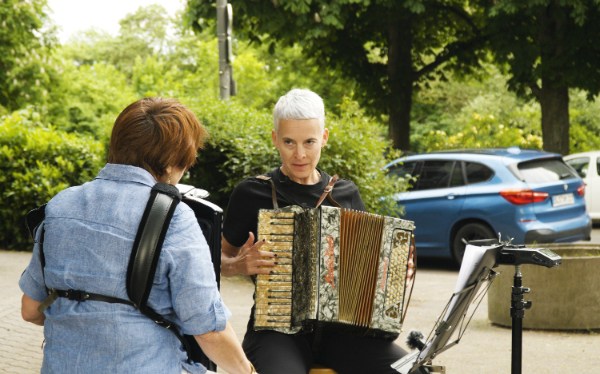
Understanding this tense situation is crucial for visiting the festival in Graz, where Breitz presented a new video piece for the first time in years. The piece is based on the life of Esther Bejarano, who was deported to Auschwitz in 1943 and survived by playing the accordion in the Women’s Orchestra. After the war, she emigrated to Palestine, where she witnessed the Nakba – the expulsion of Palestinians – before returning to Germany in 1960. She remained an outspoken critic of Israel and a prominent activist against antisemitism, racism, and fascism for the rest of her life, actively preserving the memory of the Holocaust through speeches and music. Bejarano’s story has received a mixed reception in Germany. In Breitz’s video, it turns into a rhetorical question: ‘Can music float above violence and brutality?’ Coincidentally, the same question recently arose in Belgium during a debate over an Israeli orchestra conductor who was uninvited for a concert in Ghent for failing to unequivocally distance himself from the Israeli government. The Belgian prime minister condemned the decision as racist and antisemitic, and attended a concert in Germany to signal his support for the conductor. This may seem like a minor incident, but it is proof of just how deep the political rifts run, extending far beyond national borders.
Germany, a country that insists on its historic responsibility toward Israel now finds itself deeply divided – its art world included – over its refusal to condemn the genocide in Gaza.
Underbelly
In her opening speech, Ekaterina Degot declared that ‘art is only considered free when it is free from politics’. This bold statement serves as a warning against the instrumentalization or censorship of art, particularly in Austria, where the far-right Freedom Party (FPÖ) gained significant ground in the last election. At the same time, it suggests that art can never be entirely free, since it is inherently political in the broader sense of the term. Artists never operate in a vacuum – music conductors included. There is freedom from but also freedom to: to express, to distribute, to participate in cultural life. With its radical, anti-fascist legacy since 1968, steirischer herbst remains a much-needed platform where nuance and complexity can be voiced – at least for now. Its main site this year is a derelict distillery in a migrant district. Many of its residents are unable to vote, unlike the far-right electorate casting ballots against them.
The unconventional exhibition venue yields a site-specific scenography that fuels both artistic invention and curatorial imagination. On the ground floor, the artist duo Angélique Aubrit and Ludovic Beillard presents a new installation, commissioned by the festival. Spread across different office rooms, it features larger-than-life puppets as the protagonists: three weasels, a ruined banker, and a vagrant. Set in a post-capitalist, post-apocalyptic world where A.I. controls everything and money has lost its value, the mise-en-scène – complete with voices and props – will later be incorporated into a film the artists are making. Their elaborate scenario is both mesmerising and disturbing. Although the installation appears to be perfectly integrated into the exhibition, as if the characters have long inhabited this part of the building, their theatrical language is designed to create an alienation effect. The uncanniness of Aubrit and Beillard’s work resonates with pieces from previous editions of the festival, such as those by Jos de Gruyter & Harald Thys or Diederik Peeters.
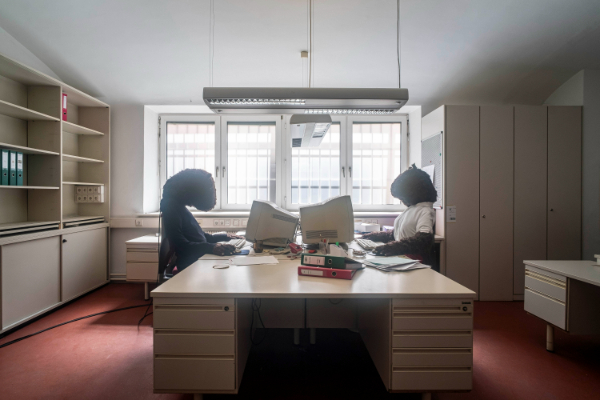
A dark undercurrent also runs through the work of Pauline Curnier Jardin. She created a new film in co-production with NW, Open House for Contemporary Art and Film in Aalst, Belgium, exploring the city’s controversial carnival tradition, rife with racist, homophobic, antisemitic and misogynist stereotypes embedded in the costumes. Rather than serving as an inversion of hierarchies or a form of resistance against authority, the Carnival of Aalst has largely become a celebration of bad taste. Steering clear of moralistic judgements, Curnier Jardin used on-body cameras to create a montage that exposes the abject, nauseating underbelly of this folkloric practice, focusing in particular on the Voil Jeanetten, traditional figures representing the inversion of gender roles.
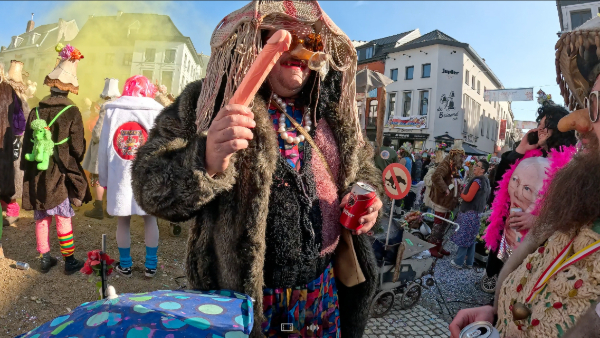
Other works are more subtle, such as the poetic installation by Carla Åhlander and Gernot Wieland in a former family apartment at the top of the building. Their work consists of pages from a family photo album hung against the walls. The photographs have been removed, leaving only the handwritten captions to engage the visitor’s imagination. Their juxtaposition discreetly comments on the Schweigekultur – the widespread silence surrounding Nazi collaboration and complicity in war crimes in postwar Austria. In an adjacent room, a piano piece inspired by the patterns of the original, faded wallpaper can be heard, as a spectral echo from a not-so-distant past.
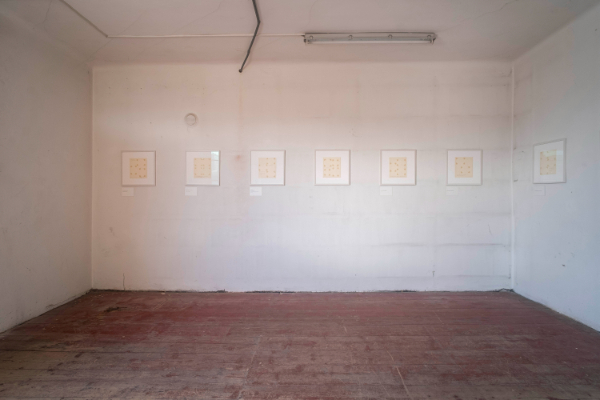
If contemporary art serves as a critical lens on the zeitgeist, then the festival in Graz offers a bleak and sometimes foreboding perspective. Yet, it is precisely through its aesthetic mediation that steirischer herbst distinguishes itself. The Vienna-based collective Gelitin, for example, invites visitors one by one into the building’s water-filled basement. In this dark underworld, one must strike a triangle to summon the ferryman, much like Charon in Greek mythology, who guides visitors into a dreamlike phantasmagoria of installations and sculptures. German artist Olaf Nicolai had a radio studio built for concentrated listening to an unusual recording: the song of nightingales, accompanied by a low humming sound. This piece is based on an original 1942 BBC broadcast in which the birdsong was interrupted by the drone of British bombers passing overhead – both fragile and chilling. One of the more whimsical notes in the exhibition is certainly the installation by Ahmet Öğüt. Sports Club for the Forbidden Colors reclaims censored color codes – such as the Kurdish flag or rainbows flags – by weaving them into absurd sports like hobby horsing or bed racing. The project transforms suppressed symbols into a collective protest using humor as its weapon.
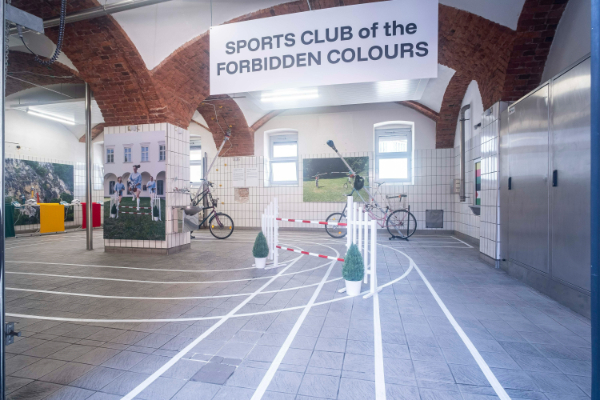
Dogs and wolves
Paintings are a rare sight at the festival, but one piece by the late Belgian artist Philippe Vandenberg made a strong impression. Titled D’après l’ennemi intérieur (After the Enemy Within), the painting depicts a haunting scene: human figures crawling on all fours with dogs seated on their backs. The work draws us deep into the human psyche. The dog is a recurring motif in Vandenberg’s oeuvre, perhaps symbolizing a dog-eat-dog world or the homo homini lupus (man is a wolf to man) idea that captures Hobbes’ vision of the brutal and violent state of nature. From dog to wolf – an association that was easily made during an evening performance by Augustin Maurs at Dom in Berg, an event venue carved into a hill and originally constructed as a World War II air-raid shelter. What began as a lecture-performance tracing the symbolism of wolves from ancient myth to modern representation transformed into a musical meditation on the ‘wolf tone,’ a dissonant interval that resists the conventions of Western harmony. The piece concluded with a chilling chorus of howls from the performers, eerily reminiscent of an air-raid siren.
The wolf is never far from politics. ‘Who’s Afraid of the Big Bad Wolf?’ is a well-known song from a 1933 Disney cartoon. In the original version, the wolf appeared disguised as an antisemitic caricature – a portrayal revised in later versions. Over time, the wolf came to symbolize the encroaching threat of fascism, while the three little pigs were recast as figures in a propaganda narrative about wartime resilience and vigilance. Today, the question returns: under what masks, with what seductive rhetorics, does authoritarianism slip into the world once more? If we are indeed living in prewar times – a lament frequently heard during the festival – then who and what is adding fuel to the fire?
If we are indeed living in prewar times – a lament frequently heard during the festival – then who and what is adding fuel to the fire?
Violenza addresses this question head-on. In this theater piece, developed by Michiel Vandevelde, Pankaj Tiwari, and Eneas Prawdzic, five young right-wing men from Austria and Germany are invited to voice their ultraconservative views on the Bühne – or so it is announced. Without any censorship from the directors, the result is an hour-long, grotesque rant of sexist, racist, transphobic, misogynistic, patriarchal, and otherwise discriminatory diarrhoea, punctuated by Heimat songs and a reactionary yearning for classicist aesthetics. For Michiel Vandevelde – who has never shied away from politics as a choreographer, curator, and performer – this is perhaps his most radical and provocative work to date. Violenza seizes the festival’s satirical leitmotif and pushes it to an intolerable extreme. This ready-made gesture – isolating and transplanting raw right-wing discourse into a theater context – triggered uneasy shuffling in seats, occasional booing, and, above all, laughter. But it remains hard to guess what that laughter conceals: moral superiority, contempt for bad taste, nervous discomfort, a morbid sense of humor – or perhaps a frustrated suspension of disbelief, which may be exactly what the makers are after? As Bertolt Brecht noted in 1938, ‘Those who laugh, haven’t heard the news yet’. Ultimately, Violenza leaves us with more unease than clarity, a nec plus ultra reflecting the division and outright despair within today’s cultural landscape.
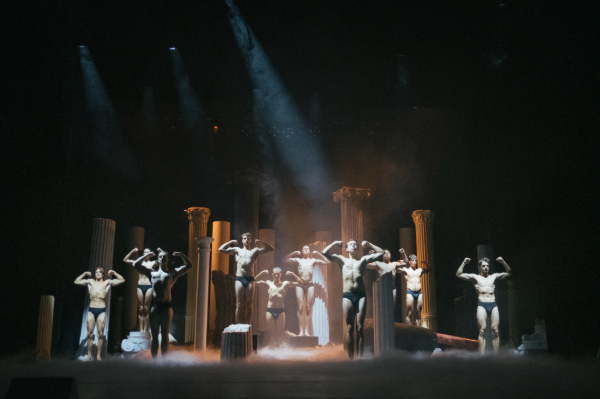
In Three Guineas (1938), written on the brink of World War II, Virginia Woolf confronts us with a blunt truth: war is a man’s business. In order to understand and prevent war, along with its glorification of violence, one must confront patriarchy and its mechanisms of authority, hierarchy, and enforced submission. In response, Woolf imagined a female countercommunity, a ‘Society of Outsiders’, which resists the fascist spirit through imagination and solidarity. In their recent work, Judith Butler carries this insight further, extending it to all forms of structural inequality, exclusion, and oppression. According to Butler, pacifism is not merely a passive stance. Genuine nonviolence demands both an acknowledgment of our primal aggressive impulses and the formation of ethico-political alliances that actively dismantle the structures and hierarchies that produce aggression – before it’s too late. Butler’s name recently appeared on a list of 160 individuals – students, faculty, and staff – provided by the University of California, Berkeley, to the U.S. Department of Education amid a federal investigation into alleged antisemitic incidents on campus, following pro-Palestinian demonstrations in 2023. It is a stark reminder of the current challenges. Nie Wieder Friede (Never Again Peace) is more than a satirical sneer or literary trope – it is an ominous foreboding. War does not take place in the distance; it is already here, lurking at our doorstep. The need for resistance is real – on multiple fronts, including culture. The questions are pressing: Can art contribute to the force of nonviolence? And in the face of authoritarianism, imperial aggression, and rising militarism, will we organize and take action together, or will we simply howl along with the wolves?
Pauline Curnier Jardin will be exhibiting her work at two institutions in the near future: at M HKA from 10 October 2025 to 25 January 2026, and at Netwerk Aalst from 31 October 2025 to 29 March 2026.